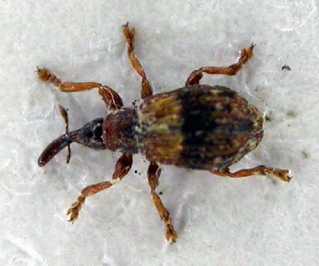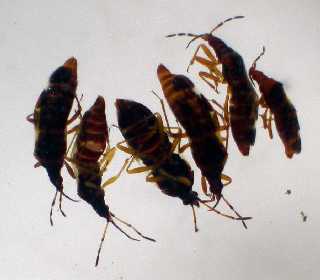

Worcestershire Record No. 17 November 2004 p. 24-25
Harry Green & John Meiklejohn
Pictures all ©Harry Green
In 2000 we wrote a short note about the invertebrates found on mistletoe (Green & Meiklejohn 2000). We also quoted a press comment on the “Kiss me slow beetle” which had been discovered at the Brockhampton Estate near Bromyard, in Herefordshire. This referred to the recent first British record of Ixapion variegatum, a small weevil of mistletoe. At the time we regretted that Ixapion had not been found in Worcestershire! .
Following on from the discovery, Foster, Morris & Whitehead (2001) published a definitive paper on the weevil, including identification, modification of national identification keys, its distribution, biology and ecology. They also reported discovery of the weevil in an orchard near Pershore, and one in West Gloucestershire. This paper is essential reading for those interested in both mistletoe and weevils. Drane (2001) later reported finding it near Hope-under-Dinmore about 12 miles west of the Bromyard site.
On 28th August 2004 we visited Carpenters Farm, near Berrow, Worcestershire, by kind invitation of Ian & Helen Macleod, and Martin Skirrow. There is an old orchard on the farm, mainly of apple trees, many carrying mistletoe. JM collected bugs and Psyllids from the mistletoe and on later examination found amongst them a small weevil he could not identify. He showed the specimen to Paul Whitehead who identified it as Ixapion variegatum. Once seen the weevil is fairly easy to identify.
Inspired by this success HG attacked the mistletoe in his garden in Little Comberton on 26th September! Shaking a series of lush clumps produced various bugs (see later) but no weevils. He then visited (on 5th October) Rough Hill Orchard, near Birlingham (now owned by People’s Trust for Endangered Species) which contains many ancient decaying apple trees carrying mistletoe. Amongst the invertebrates shaken from the mistletoe were two Ixapion variegatum, identity confirmed by JM. Following this discovery HG returned to his own garden on 5th October and collected invertebrates from rather stressed-looking mistletoe on an apple tree that was dying back. On this occasion he found one Ixapion variegatum!
Following consideration of European data Foster et al (2001) suggest that Ixapion variegatum exists throughout its west European range at low densities and appears to increase when mistletoe is perhaps under stress on trees which are gradually dying. Interestingly, the old apple trees at Carpenters Farm, Rough Hill Orchard and at Little Comberton are all aging trees showing die-back and stressed mistletoe.
As is well-known mistletoe is nationally most abundant in Herefordshire, Worcestershire and Gloucestershire, although widely distributed in England (Preston et al 2002 for modern distribution map and references). Many of the early studies of mistletoe were made in Herefordshire. Ixapion variegatum has been discovered in the heart of mistletoe country. Has it always been there or has it arrived recently? Foster etc (2001) suggest “… that the weevil is a long-established but overlooked representative of the British fauna rather than a recent arrival”.
|
|
|
| Ixapion variegatum Natural size of beetle varies between 2.1 and 2.8 mms in length | Anthocoris visci, a predatory bug found on mistletoe |
Other invertebrates of mistletoe.
| Anthocoris visci (Hemiptera. Cimicidae) a predatory bug | |||||||||||||||||||||||||||||||||||||||||||||||||||||||||||||||||||||||||||||||||||||||||||||||||||||||||||||||||||||||||||||||||||||||||
| Orthops viscicola (Hemiptera, Miridae) a plant sucking bug | |||||||||||||||||||||||||||||||||||||||||||||||||||||||||||||||||||||||||||||||||||||||||||||||||||||||||||||||||||||||||||||||||||||||||
Psylla visci (Psyllidae) A jumping plant louse specific to mistletoe
| Celypha woodiana (Lepidoptera) a leaf mining tortrix moth specific to
mistletoe. | The first two were found on all our searches of mistletoe in Worcestershire referred to above. Psylla visci was not found although a similar insect Psylla mali was often abundant. Although Anthocoris visci is supposed to prey exclusively on Psylla visci, this seem unlikely in the circumstances and Foster et al (2001) suggest it is predatory on other small insects living amongst mistletoe. The tortrix leaf miner has not been found since 1980. Indeed Tony Simpson asked people to look for its leaf mines in April and early May (Simpson 2003). Discussion Is Ixapion variegatum a new arrival or has it been overlooked? Well, it is very small, and belongs to a “difficult” group of beetles, so perhaps it has escaped attention. However 19th century Herefordians were fascinated by mistletoe and both Anthocoris visci and Celypha woodiana were both found and described in Herefordshire (Foster et al 2001) and there has been a continuing interest in mistletoe fauna ( a couple of references in our earlier note). It seems surprising that a rather striking small weevil was overlooked in the past. We shall never know. English records of Ixapion variegatum are occurring in late summer and autumn. Foster et al (2001) quoting European studies say that the species may over-winter as eggs or beetles. The larvae live in mistletoe stems from April to July and after pupation the adults mate in July and August. They can fly so dispersal may occur at that time, which is when our records have occurred. Further study or the biology of English Ixapion variegatum would be valuable and interesting in its own right and for a conservation point of view as it is a rare insect. Its survival may depend on maintaining old rather decrepit orchards It is undoubtedly worthwhile looking for mistletoe fauna both for this weevil and other species. Whether or not the weevil is a newcomer, it does seem to be increasing its distribution in England. It would also be useful to investigate mistletoe on other common hosts – limes, poplars and hawthorn, for example
Acknowledgements: References: DRANE AB 2001 Another Herefordshire locality for Ixapion variegatum (Wencker)
(Apionidae). The Coleopterist 10 (3): 91. | FOSTER AP, MORRIS MG & WHITEHEAD PF 2001 Ixapion variegatum (Wenker,
1864) (Col., Apionidae) new to the British Isles, with observations on its
European and conservation status. Entomologist’s Monthly Magazine 137:
95-105. | GREEN H & MEIKLEJOHN J 2000. Mistletoe bugs. Worcestershire Record.
9: 23. | PRESTON CD, PEARMAN DA & DINES TD 2002 New atlas of the British &
Irish Flora.
Oxford University Press | SIMPSON ANB 2003 Celypha woodiana: A rare and localised insect for
recorders to look out for. Worcestershire Record 14: 17 |
| |||||||||||||||||||||||||||||||||||||||||||||||||||||||||||||||||||||||||||||||||||||||||||||||||||||||||||||||||||||||||||||||||||